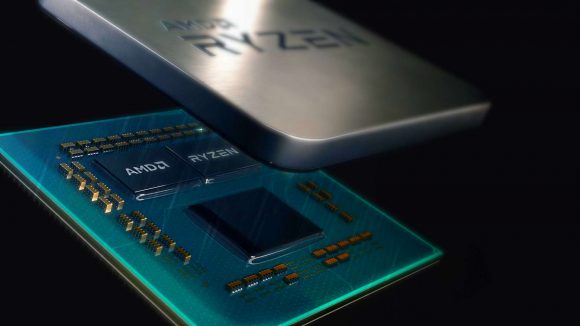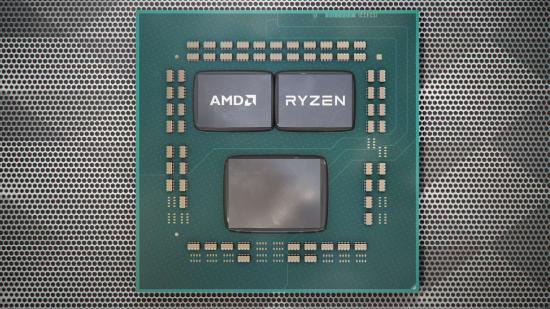AMD will continue to use solder in the Ryzen 3000 series of desktop CPUs to connect the different dies to the main heat spreader. That will probably not come as much of a surprise to regular readers, given that the Ryzen 2000 and the more-recent 3000-series APUs have all come soldered, but it is still welcome news. Especially for overclockers, though it’s not going to stop De8auer from delidding the crap out of his chips…
It’s also arguably more important for the new Zen 2 chiplet design given that there are up to three distinct dies which need to be cooled under that plain AMD lid. How the air gap between the I/O chip and either the one or two other chiplet dies will come to impact the heat the new Ryzen 3000 CPUs generate is still up for debate. It’s also going to be interesting just how coolers will cope with the offset heat generation of the new chips too.
But it has now been confirmed, from the keynote show floor, that AMD will be using solder for all the new AM4 Zen 2 SKUs, from the 12-core Ryzen 9 chip and down through the stack.
The news comes from a report by Mynavi (no relation) in Japan where the reporter, Yusuke Ohara, began digging for more information post-keynote. Most of their questions met the same stock “stay tuned” response that we got when we asked about Ryzen 3000 overclocking, but they did get a solid answer about the type of thermal interface material the company was using with the new range of processors, and it is “continued to be stated as solder.”
Clicky clacky: These are the best gaming keyboards around today
The cooling of the new chiplet-based processors is definitely something that interests us, especially given that most CPUs have the greatest amount of heat sitting almost directly in the middle of the chip and heat spreader. With Ryzen 3000 that will change as I would expect it would be the offset chiplets which will generate the most heat and they are off to the side of the processor package.
That could be even more pronounced with the single chiplet SKUs under the Ryzen 7, 5, and 3 ranges. In those instances you’ll have the main heatsource sitting in just one corner of the package. How that might affect performance under standard coolers is yet to be uncovered… if it actually does at all.

I could see an eight-core, dual-chiplet SKU being a little more balanced in terms of heat than the planned single-chiplet eight-core designs. Though there are currently no announced plans to create such a processor, and that would also likely increase the cost of such a SKU. Though a special edition octa-core Ryzen 7, using a pair of chiplets and therefore twice the potential L2 cache (there is up to 32MB of L2 in each chiplet), could be an option in the future.
As for the core layout, each of the current Zen 2 chiplets contains the potential for a pair of four-core CCX, in a 4+4 design. The Ryzen 9 3900X, with its second chiplet, is then balanced to have six active cores in each chiplet. That would likely mean a 4+2 design for each of the Ryzen 9 chiplets. The Mynavi report states that it won’t come with an asymmetric configuration, where one chiplet has the full eight cores and the other comes with one entire four-core CCX disabled. Presumably that’s to avoid any weird core-loading between the two chiplets.
We’re not going to have to wait too long now to get all the thermal and general performance answers nailed, as the July 7 Ryzen 3000 release date is creeping ever closer.
